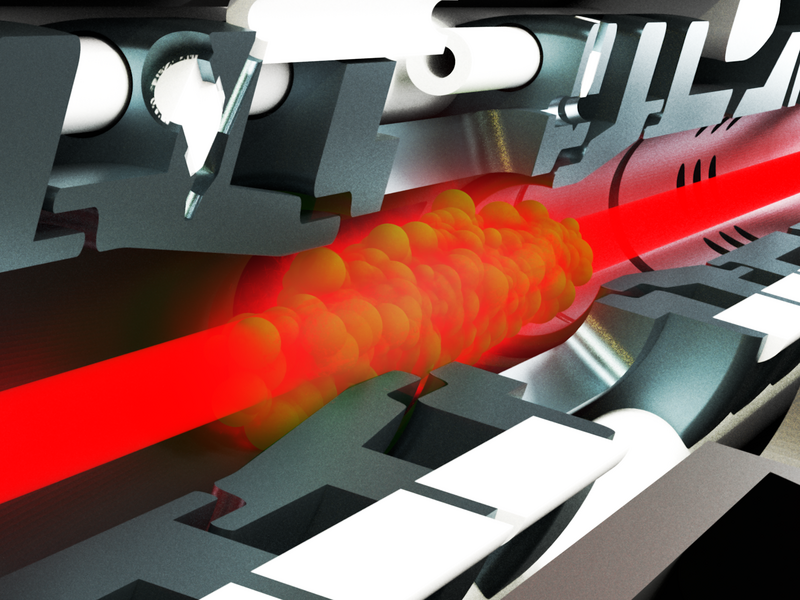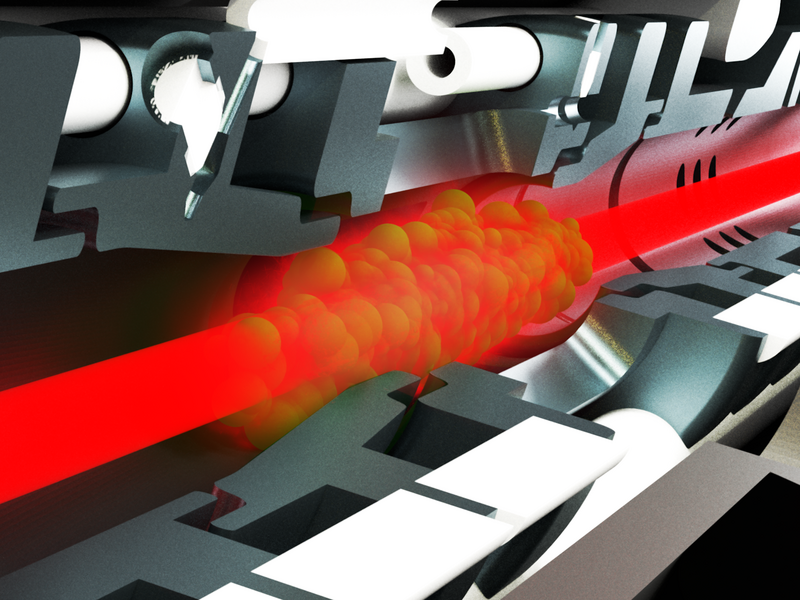Getting a Clearer View of Iron Emission Lines
Atomic x-ray line spectroscopy is a nonintrusive diagnostic method for studying hot plasmas in fusion experiments on Earth and in energetic environments of outer space [1]. Chandra and XMM-Newton—two currently orbiting x-ray telescopes—use this technique to provide critical information about a wide range of astrophysical systems, including hot gas in galaxy clusters, accretion disks around black holes, and coronal envelopes of stars [2]. An important species in these environments is ionized iron, in particular, the highly ionized state Fe+16 (also called Fe XVII), which, like a neon atom, has ten bound electrons. However, the usefulness of the most prominent lines of “neon-like” iron has been limited by a long-standing discrepancy between measurements and theoretical predictions (see Synopsis: Resolving Discrepancies in X-Ray Astronomy). Now Steffen Kühn from the Max Planck Institute for Nuclear Physics in Germany and colleagues have performed experiments and data analysis that resolve this discrepancy [3]. This result will reduce uncertainties in models of gas turbulence in galaxies, for example.
Spectral emission lines are often the only thing that researchers have to go on when studying a hot plasma. Analyzing such a spectrum requires comparing it to a database of synthetic spectra, which are calculated using a host of inputs that include atomic structure and atomic processes (which determine line intensities) and plasma perturbations (which impact spectral line profiles). The discrepancy with neon-like iron concerns one of these inputs: an atomic characteristic called the oscillator strength.
The oscillator strength can be thought of as the amplitude of electronic (dipole) oscillations in an atom. More specifically, this dimensionless parameter describes the probability that a certain atomic transition will absorb or emit light. The oscillator strength impacts many of the microphysics aspects of atomic spectroscopy. For example, the oscillator strength is a key factor in atomic processes, such as spontaneous radiative decay, stimulated emission, and photoexcitation. These processes compete with each other and with collisional atomic processes in the plasma, and this competition determines the level population, which is the relative number of atoms in a particular excited state [4]. The level population can be further combined with the atom’s oscillator strengths to predict the line emission spectrum from the plasma. As this light tries to escape the plasma, it can be reabsorbed by other atoms—a process called radiation transport, which is again dependent on the oscillator strengths [5].
Kühn and colleagues focus on the oscillator strength ratio of two strong 3d-2p line emissions in neon-like iron. Knowing this ratio is important for interpreting the spectra from hot plasmas (temperatures of 1–10 million degrees). Atomic theory calculations predict that the ratio should be close to 3.5, but measurements have found lower ratio values around 3.0. Subsequent studies have suggested that blending of different lines caused the measurements to be too low. To settle the issue, researchers require targeted iron excitation and high-resolution spectroscopy, but previous experiments have particularly lacked the latter. Kühn and colleagues have managed to measure the oscillator strength ratio using several groundbreaking technical accomplishments.
The team performed their experiments at the German Electron Synchrotron (DESY). To produce neon-like iron ions, the researchers used the PolarX-EBIT, which generates a monoenergetic electron beam that impacts on target iron atoms to produce highly charged ions. The resulting ions are trapped in the radial direction perpendicular to the beam by the negative charge potential produced by the same beam (Fig. 1). To study the 3d-2p line transitions in neon-like iron, the team used x-ray light from the PETRA III synchrotron to photoexcite the upper levels of the 3C (resonant) and 3D (intercombination) transitions, whose oscillator strength ratio was the focus of the investigation.
The researchers achieved unprecedented precision by employing two technical improvements. First, they reduced the background level by periodically changing the electron beam energy between drive and probe cycles, leading to a 1000-fold increase in the signal-to-noise ratio compared to the team’s previous result [6]. Second, they tuned the aperture and other elements of the x-ray optics to obtain a spectral resolving power of 20,000, which is two-and-a-half times better than their earlier effort.
These improvements allowed the team to remove the blending with nearby transitions and fit the line intensity distributions to Voigt line shapes. A particular Voigt shape represents the convolution of Gaussian and Lorentzian line profiles, that is, line intensity distribution curves. The Gaussian curve is associated with the Doppler broadening effect that arises from thermal microscopic motion of the emitting atoms. The Lorentzian curve is related to the natural broadening effect that is set by the finite lifetime of the excited states. The analysis by Kühn and colleagues exposed for the first time the contribution of the Lorentzian wings, which had previously been buried in the background. Isolating the Lorentzian contribution resulted in a precise measurement of the total line intensities. The ratio of these line intensities produced a ratio of 3.51 for the oscillator strengths of the two iron lines.
On the theory side, Kühn and colleagues redid calculations for the oscillator strengths. Their advanced atomic structure theory calculations employed relativistic effects and included 1.2 million atomic configurations, which were needed to perform a thorough assessment of configuration interactions. The team’s effort provided an accurate calculation of state wave functions for computing the electric dipole matrix elements needed for the oscillator strength evaluations. Ultimately, their high-quality theory results were consistent with their high-quality measurements, and both agreed with earlier theoretical calculations.
This work represents a remarkable achievement of experimental atomic physics enabled by technical breakthroughs, excellent data analysis, and identification of sources of uncertainties (statistics and systematic). The resolution of this long-standing problem with neon-like iron oscillator strengths will help in analyzing future spectroscopic observations, such as those expected from the Japan Aerospace Exploration Agency’s X-Ray Imaging and Spectroscopy Mission (XRISM), which is expected to launch in 2023, and from the future European Space Agency’s Athena x-ray observatory mission, which is slated for 2030.
References
- H. R. Griem, Principles of Plasma Spectroscopy (Cambridge University Press, Cambridge, 1997)[Amazon][WorldCat].
- D. W. Savin et al., “The impact of recent advances in laboratory astrophysics on our understanding of the cosmos,” Rep. Prog. Phys. 75, 036901 (2012).
- S. Kühn et al., “New measurement resolves key astrophysical Fe XVII oscillator strength problem,” Phys. Rev. Lett. 129, 245001 (2022).
- Modern Methods in Collisional-Radiative Modelling of Plasmas, edited by Y. Ralchencko (Springer, Switzerland, 2016)[Amazon][WorldCat].
- D. Mihalas, Stellar Atmospheres (W. H. Freeman & Co., San Francisco, 1978)[Amazon][WorldCat].
- S. Kühn et al., “High resolution photoexcitation measurements exacerbate the long-standing Fe XVII oscillator strength problem,” Phys. Rev. Lett. 124, 225001 (2020).





